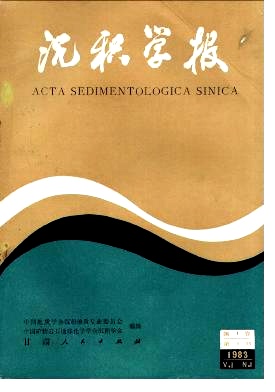SEDIMENTARY FACIES INDICATORS OF BIOMARKERS AND THEIR MOLECULAR PARAMETERS IN TERRESTRIAL BASINS
- Received Date: 1982-05-28
- Publish Date: 1983-03-10
Abstract: Sedimentary facies is the major control of petroleum origin, migration and distribution in terrestrial basins.The common study methods of sedimentary facies are based on the characteristics of sedimentary sequence and various markers such as rock facies, mineral facies, biological fossils, trace fossils, rock structure, etc.and they are classified by geochemical indicators.We have used GC-MS to analyze the samples of different sedimentary facies (swamp facies, littoral and shallow water lacustrine facies, subdeep-deep water lacustrine facies) of triterpanes and steranes in an attempt to find out the sedimentary facies indicators of biomarkers and their molecular parameters in terrestrial basins Sedimentary facies indicator of biomarkers is one of the means of measarement to study sedimentary facies on molecular level and it is also a complemental means to the conventional methods.In geological period,the biomarker compounds had more stable carbon skeleton, they transferred the informations of primary living organisms, and were closely related to biological bodies.The study of sedimentary facies of terrestrial basin shows that the type of organic matter in source rocks is controlled on the plane by the belts of the sedimentary facies.Land plants are mostly distributed on the lakeshore, whereas aquatic organisms at the central part of the lake.Therefore, the biomarkcrs used to recognize the type of organic matter and their molecular parameters may also be used as compounds of facies indicators of biomarkers. Different facies from lower Cretaceous Qingshankon 2-3 member of Songliao basin, and samples of different ages but in the same sedimentary facies from Pale-agene Shahejie formation of Bohai Bay basin, lower Cretaceous Qingshankon 2-3 member of Songliao basin, Jurassic Yunan formation of Erduosi basin have been analyzed by comparing and examining triterpanes and steranes from different sedimentary facies along with geological and geochemical data, and therefore we have got some knowledge about sedimentary facies indicators of biomarkers of the terrestrial basin. Based on the study of biomarker in sedimentary facies belts from the basins,we have suggested that oleanane, C29-hopane/C30-hopane, Tm/TS,ΣC27 + C29-hopane/Σ C30-hopanes andΣC27-steranes/Σ C29-steranes, 4 -methyl-C29-steranes/5α-C27-ster-anes can be used as indicators of the biomarkers and molecular parameters. By using geochemical parameters, the sedimentary facies bands may be classified as follows: The swamp facies,in general,contain oleanane and C29-hopane/C30-hopane, Tm/TS, Σ C27+C29/Σ C30 are higher, while in steranes Σ C27/Σ C29 is relatively lower but the 4 -methyl-C29/5α-C27 higher.The characteristics of subdeep-deep lacustrine facies is contrary to the previous discussion.The lakeshore facies are moderate in characteristics of the two mentioned above. The authors believe that better results can be acheivcd if facies indicators of biomarkers and their molecular parameters are used to classify the sedimentary facies in company with geological and geochemical parameters.The biomarkers and their parameters suggested in this paper have shown their applicability to the samples studied.
| Citation: | Shang Huiyun, Jiang Naihuang. SEDIMENTARY FACIES INDICATORS OF BIOMARKERS AND THEIR MOLECULAR PARAMETERS IN TERRESTRIAL BASINS[J]. Acta Sedimentologica Sinica, 1983, 1(1): 107-117. |






 DownLoad:
DownLoad: